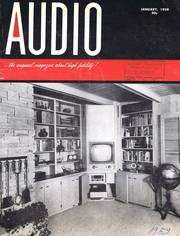Erläuterungen zu diesen US-AUDIO Seiten der 1950er Jahre
Die hier stehenden amerikanischen Artikel aus 1959 (aus der US-AUDIO) sind teilweise sehr gewöhnungsbedürftig, weil sie erstens aus einer längst vergangenen Zeit stammen und zweitens, weil dort in den USA ganz "anders" gedacht wurde als bei uns in Old Germany oder in Europa.
Vergleichbar mit unseren deutschen Hifi-Magazinen etwa ab 1962 ist jedoch, daß auch dieses Audio-Magazin ihre Anzeigen- Kunden und -Leser am Markt oder von anderen Magazinen (be- oder ab- ?) werben mußte. - Weiterhin sind die riesigen Dimensionen des amerikanischen Kontinents mit unseren hier in Europa nicht vergleichbar. - Ein Redaktions-"Trip" von New York nach Los Angeles oder Chicago oder gar in die Wüste nach Las-Vegas zu einer der CES- Audio- "Shows" war - auch mit dem Flugzeug - immer noch eine halbe Weltreise. Und jede Ausstellung oder "Messe" wurde als "Show" deklariert. Und natürlich, in USA musste alles "Show" sein, um beim Publikum einige Aufmerksamkeit zu erzeugen.
.
Die monatliche Kolumne - Editors' REVIEW - das Editorial
"RED FACE DEPARTMENT"
Hardly anyone is perfect, but we sometimes wonder why we keep trying to prove the truth of this old saying. In particular, we are referring to a New Products item at the bottom of page 76 in the February issue which commenced, "Hardly any desirable audio control function is incorporated in the Pilot Model 216 stereophonic preamplifier ......."
Now we don't think any of Audio's readers would take this at its face value (wortwörtlich als bare Münze) - anyone ought to know that if we thought the product had no desirable features we would simply ignore the publicity release and leave everything unsaid. However, two people were mislead and mentioned it to us, so we could rectify the error.
Actually, the original release was correct; our New Products editor wrote it correctly; the printer set the type correctly; and finally, one of our own proofreaders spied the "not," thought it was in the wrong place, and marked it to be deleted. The obliging printer, not being expected to edit the magazine too, removed the "not," which was not right. So now we have to write about the "not" that was not written in the magazine, and we hope it will not happen again. Not that we expect it not to.
Anyhow. Pilot gets another mention of the SP-216 - which is a slightly improved model of the SP-215 about which we have commented favorably many times.
Noch ein paar Korrekturen aus Dec. 1958
While we are in an apologetic mood, we offer the following corrections to the November 1958 article by Philip B. Williams and James F. Novak, "Improvements in 'air suspension' speaker enclosures with tube venting." Equation (8) should have had a radical sign over the first 2 in the denominator; in Fig. 2, MMR should have been shown as equal to "Total air load mass, kilograms," instead of "Total IE load ..." ; the abcissa of Fig. 7 should have read "Frequency in cycles per second" instead of w/w8; and the abcissa of Fig. 8 should have been w/ws instead of w/w0. The Fig. 2 error was our fault; and the authors are kind enough to say that the other mistakes were theirs.
No matter how hard we try, these errors will etc. etc. etc. etc.
STEREO RECORD QUALITY (Anfang 1959 !!)
We still hear comments from some readers - with, possibly, short memories - relative to the alleged poor quality of stereo records. To be sure, we have heard some poor stereo records, but we have also heard some superb ones.
Furthermore, we have seen consistent improvement in record quality since the first ones were introduced over a year ago. By and large, we believe the record industry has taken a new tool and within the short space of a year has learned new techniques of record cutting and processing, to say nothing of microphone techniques, which are not yet standardized but which are being employed rather dramatically in many instances to produce excellent records.
Liegt es vielleicht an der vertauschten Phase ?
When we consider how many times we have heard poor stereo reproduction - and so often due only to an out-of-phase condition of the speakers - we can understand why the records are often blamed.
But when the system itself is right - and that proves itself if at least some records sound good - there are many, many good stereo records. Our own collection is not large, compared to the monophonic collections of the average music lover, but at last count it numbered about 65 records. And of those 65 we would say that at least half are excellent, and only a dozen poor.
Wenn natürlich der Plattenspieler zu billig ist
One would not think of evaluating monophonic LP record quality by playing the discs on a table model phonograph of the $29.95 Hifi variety. And it is just as important that the system be of top quality for stereo - if not more so - than for monophonic reproduction. Remember, furthermore, that some of the first LP's were far from perfect.
Occasionally we receive an irate letter from a reader who says he would never buy a stereo record because "they are no good" or that "they have a false stereo perspective," or for some other reason.
We do believe that there is a variation in recording and microphoning techniques, but we also believe that it is necessary to take a little more care in setting up a stereo system - both electrically and acoustically, with the accent on the latter - than it is for a good monophonic system.
Perhaps we have been lucky in either records or equipment, or both, or perhaps we have expended more effort in getting what we consider satisfactory reproduction. But the result is that we think many stereo records are excellent, we have dropped our membership in the Metropolitan Opera Record Club until they are in stereo, and we will not buy any more monophonic records unless some performer we wrant is not yet recorded stereophonically.
But that is only our opinion.
Kommentar zu den "WEST COAST SHOWS"
Unfortunately, the San Francisco and Los Angeles shows were too late for any report in this issue. The "Cow Palace" show in San Francisco differed from the typical room shows held heretofore, and readers will undoubtedly be interested in how the new type of show building went over. We would too, but we will also have to wait a while longer.


